Creators as the New SEM: Build Searchable Trust, Not Just Impressions

Creators as the New SEM: Build Searchable Trust, Not Just Impressions
TL;DR
Creators are becoming a performance channel, not a side stunt.
The most effective brands treat creators like SEM: searchable, measurable, and built around intent—not just vibes. The goal isn’t “influencer moments”; it’s persistent content that prospects find when they’re actively deciding.
Precision beats scale in the creator era.
Brands win when they match “right-fit” creators to specific problems and searches, then measure outcomes with the same rigor as paid search: UTMs, lift, and revenue—not likes.
The playbook: treat creator content as inventory, not decoration.
Map creators like keywords, brief them like media partners, build reposts and search assets around their content, and keep long-term relationships so trust compounds instead of resetting every campaign.
Why this matters now
For years, creators sat in the “nice-to-have” bucket: a sponsored post here, a branded story there. That’s changing fast. Industry research shows creator budgets growing sharply as brands reallocate spend away from legacy display and into content that feels native, useful, and human.
At the same time, platforms are shifting from friend graphs to discovery engines. TikTok, YouTube, Instagram Reels, and Shorts increasingly decide what people see based on relevance and watch-time, not who they follow. That means creator content isn’t just a fame play—it’s a discovery surface. The right video at the right moment can behave like a search ad: it shows up when someone is already primed to care.
But there’s a catch. Measurement is still messy. Many brands treat creator work like awareness wallpaper: they track reach and views, then shrug when finance asks about impact. The opportunity now is to close that gap and structure creators as a full-funnel media channel—with proper briefs, targeting, and attribution. The brands that make this shift will out-learn competitors still chasing one-off hype.
What to do this month
-
[ ] Map creators the way you map keywords.
Start with your high-intent searches and decision moments. For each, list the creators your audience actually watches: reviewers, educators, niche experts. Prioritize “searchable” content—how-tos, comparisons, reviews—over generic lifestyle shots. -
[ ] Turn creator content into reusable inventory.
Write briefs as if you’re buying media, not just content. Define goals (traffic, trials, sign-ups), required proof (demos, reviews, before/after), and formats you can reuse across channels. Plan from day one how each asset will be clipped, subtitled, and repurposed. -
[ ] Instrument every asset for measurement.
Use UTMs, landing pages, and promo codes that are creator-specific. Define the primary metric (e.g., incremental revenue, trial starts, qualified leads) and the time window for evaluation. Compare creator performance to SEM and paid social—not just to other creators. -
[ ] Build repost and search “tiling”.
Once a piece of creator content shows promise, tile it across your ecosystem:
– Turn it into a YouTube video with search-friendly titles and chapters.
– Use it as raw material for short-form paid placements.
– Embed it on product pages, comparison pages, and FAQ hubs.
The goal: make that trust findable wherever people research. -
[ ] Invest in long-term creator relationships.
Instead of one-off posts, design 6–12 month programs with your best-fit creators. Long-term collaboration improves authenticity, creative quality, and performance. Treat them as partners who learn with you—not as disposable media buys.
Evidence & caveats
The creator economy is now a large and fast-growing market, with estimates running into the hundreds of billions of dollars over the next decade. At the same time, income distribution is heavily skewed: a small slice of creators earns most of the money, while the majority remain small or part-time. That’s both a challenge and an opportunity—brands have access to a huge long tail of niche voices, but they need structure to find the right ones.
Studies from platforms and measurement partners increasingly show strong ROI from well-run creator programs—sometimes outperforming traditional paid ads on cost per acquisition. But when briefs are vague, tracking is weak, or creators are chosen purely on follower count, results tend to revert to vanity metrics. In other words: creator marketing is not magic. It’s a channel that rewards rigor.
There’s also risk. Misaligned creators, unclear disclosures, or inconsistent messaging can damage trust. That’s why brands need governance: contract terms, content review, brand-safety guidelines, and clear rules on edits and approvals.
FAQs & objections
“Isn’t this just influencer marketing with extra steps?”
Not quite. Traditional influencer marketing often focused on reach and vibes—big names, big numbers. Treating creators as SEM means focusing on intent, searchability, and measurable outcomes. You’re not just buying influence; you’re building a performance channel.
“We’re a small brand. Can we really do this?”
Yes. In many categories, smaller brands actually have an edge because they can work with niche, deeply trusted creators who speak directly to specific communities. You don’t need a million-follower star; you need three creators who own the conversation in your corner of the internet.
“Won’t this be hard to scale?”
It can be—unless you build systems. Standardize briefs, tracking templates, reporting, and contracts. Consider a lightweight creator CRM: who you’ve worked with, what you paid, how they performed, and what content exists to repurpose.
“What if creators go off-message?”
That’s where guardrails come in. Be explicit about claims, visuals, and topics that are off-limits. Share brand guidelines and examples of “great” and “not great.” At the same time, leave room for their voice—over-scripted creator content feels like an ad and loses the trust you came for.
The bigger picture
Creators aren’t replacing SEM—but they are becoming its human counterpart. Search shows people what’s available; creators show them what’s believable. When you treat creator content as searchable, measurable media instead of one-off stunts, you align those forces.
The future of this space looks less like “influencers posting ads” and more like distributed, human-led media networks: hundreds of semi-independent channels, each trusted by a specific audience, all discoverable through recommendation systems and search. Your job is to plug into that network with intent, structure, and respect for the creator’s relationship with their audience.
Do that well, and you won’t just buy impressions—you’ll build searchable trust that keeps showing up in the moments that actually change decisions.
Read similar content
Similar topics

AI Where It Helps: Variant Factories, Human Guardrails
AI boosts performance when it scales creative options and automates low-risk decisions—while humans keep judgment, claims, and brand integrity intact.

Beyond #Ad: Why Affiliate + Long-Term Creators Are Eating Paid Social
One-off influencer posts are dying; long-term creator relationships and affiliate engines now outperform traditional paid social.

Design for Stream→Search: Sequencing Content That Survives the Algorithm
Why brands need content ladders that move people from passive scrolling to active searching—and how to build sequences that compounding attention.

AI for Strategists: Where to Use It—and Where to Say No
Use AI to accelerate creative variants, analysis, and ops—keep humans for briefs, claims, and brand voice.